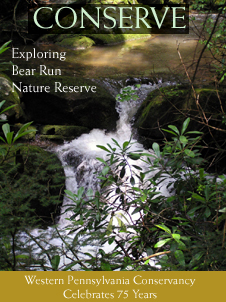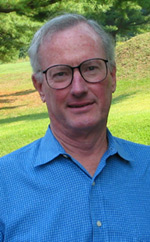
Western Pennsylvania Conservancy:
As Board Chairman, I am proud to be a part of this rich legacy and can tell you firsthand that the conservation and community ethic that brought about this organization is very much alive in our dedicated board and staff. When new challenges arise, each are met with the same thoughtful planning that began this wonderful organization. Late last year, Dennis McGrath stepped down as president of the Conservancy. During his time with us he was a great asset to the organization. He led a strategic planning process that is allowing us to effectively advance our mission now and in the years to come. A search for a new president has produced many strong candidates. It is my hope that we will be introducing the new president in the next issue of CONSERVE. Lastly, the Conservancy’s hands-on conservation work has greatly expanded during the past decade. As the number of staff members working in the Pittsburgh WPC office has grown from 22 in 1996 to nearly 70 today, the space needs of the Conservancy have far exceeded the capacity of our current downtown Pittsburgh location. This spring we will move to a building on Washington’s Landing. Washington’s Landing was formerly known as Herr’s Island and is a 42-acre island on the western banks of the Allegheny River, near the 31st Street Bridge. The island is a once-blighted brownfield that has been reclaimed and redeveloped into a multi-use development. Moving to reclaimed land that has been restored from a state of deterioration and abandonment is symbolic of the commitment WPC has to protecting and conserving our region’s natural resources. The building on Washington’s Landing will suit our needs into the foreseeable future with significantly increased and more efficient office space as well as lab space, meeting space, natural lighting and outdoor green space. Our frequent partners, the Department of Environmental Protection and the Department of Conservation and Natural Resources, have offices located there as well. The Conservancy’s roots run deep. A small group of enlightened individuals founded
the organization in 1932 and it has grown in membership and scope ever since. The legacy
of accomplishments is truly impressive, thanks to the dedication and tenacity of many
committed conservationists past and present. As the world of tomorrow becomes more
interconnected and the needs of the people become more dependent on clean streams and
healthy, natural landscapes, such dedication to the “best interests of the community” becomes even more vital.
|
Read next article | e-CONSERVE Home | WPC Home |
Conservation | Fallingwater || Gardens | |Join WPC | |Contact | Press Room
2007 Western Pennsylvania Conservancy. All rights reserved.


 I believe that these strong public-spirited roots, more than any other factor, account for
the phenomenal success our organization has seen in its 75-year history. To date, the
Conservancy has protected more than 212,000 acres of natural lands in Pennsylvania,
restored “dead” watersheds and is responsible for founding six state parks. The organization
was so highly regarded that, in 1963, Edgar Kaufmann jr. (sic) entrusted WPC with
Fallingwater, his family’s weekend home and Frank Lloyd Wright’s masterwork. He not only
donated the house, but the land surrounding it that was to become the Bear Run Nature
Reserve. We’re dedicating this issue to exploring and celebrating the 5,061 acres that
comprise this natural gem in Fayette County.
I believe that these strong public-spirited roots, more than any other factor, account for
the phenomenal success our organization has seen in its 75-year history. To date, the
Conservancy has protected more than 212,000 acres of natural lands in Pennsylvania,
restored “dead” watersheds and is responsible for founding six state parks. The organization
was so highly regarded that, in 1963, Edgar Kaufmann jr. (sic) entrusted WPC with
Fallingwater, his family’s weekend home and Frank Lloyd Wright’s masterwork. He not only
donated the house, but the land surrounding it that was to become the Bear Run Nature
Reserve. We’re dedicating this issue to exploring and celebrating the 5,061 acres that
comprise this natural gem in Fayette County.